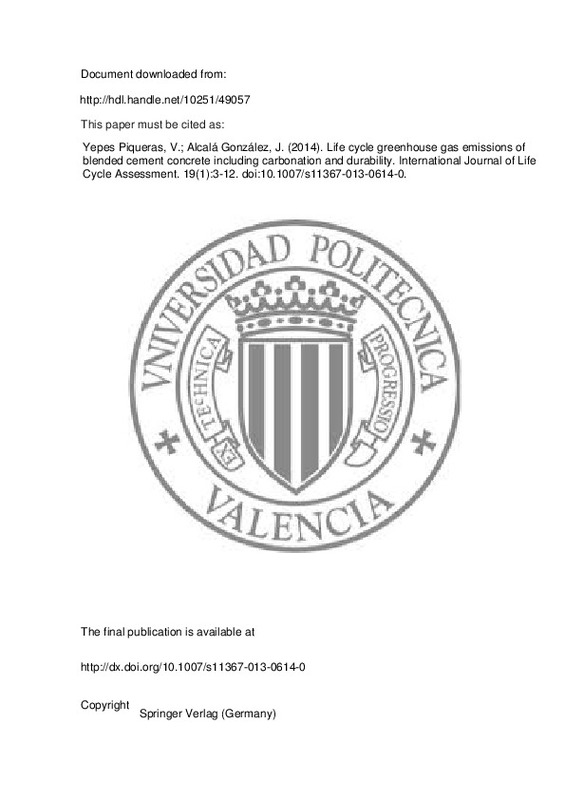Aïtcin PC (2000) Cements of yesterday and today: concrete of tomorrow. Cem Concr Res 30(9):1349–1359
Angst U, Elsener B, Larsen C (2009) Critical chloride content in reinforced concrete—a review. Cement Concr Res 39(12):1122–1138
Berge B (2000) The ecology of building materials. Architectural Press, Oxford
[+]
Aïtcin PC (2000) Cements of yesterday and today: concrete of tomorrow. Cem Concr Res 30(9):1349–1359
Angst U, Elsener B, Larsen C (2009) Critical chloride content in reinforced concrete—a review. Cement Concr Res 39(12):1122–1138
Berge B (2000) The ecology of building materials. Architectural Press, Oxford
Bertolini L, Elsener B, Pedeferri P, Polder R (2004) Corrosion of Steel in Concrete—Prevention Diagnosis. Repair, Wiley-VCH, Weinheim
Börjesson P, Gustavsson L (2000) Greenhouse gas balances in building construction: wood versus concrete from life cycle and forest land-use perspectives. Energy Policy 28(9):575–588
Camp CV, Huq F (2013) CO2 and cost optimization of reinforced concrete frames using a big bang-crunch algorithm. Eng Struct 48:363–372
CEN (2011) EN 197–1: Cement. Part 1: Composition, specifications and conformity criteria for common cements. European Committee for Standardization, Brussels
CIWMB (2000) Designing with vision: a technical manual for materials choices in sustainable construction. California Integrated Waste Management Board, Sacramento
Collins F (2010) Inclusion of carbonation during the life cycle of built and recycled concrete: influence on their carbon footprint. Int J Life Cycle Assess 15(6):549–556
Database BEDEC (2012) Institute of Construction Technology of Catalonia. Barcelona, Spain
Dodoo A, Gustavsson L, Sathre R (2009) Carbon implications of end-of-life management of building materials. Resour Conserv Recy 53(5):276–286
ECO-SERVE Network Cluster 3 (2004) Baseline Report for the Aggregate and Concrete Industries in Europe. European Commission, Hellerup: http://www.eco-serve.net/uploads/479998_baseline_report_final.pdf , accessed 10 September 2012
European Federation of Concrete Admixtures Associations (2006) Environmental Product Declaration (EPD) for Normal Plasticizing admixtures. Environmental Consultant, Sittard: http://www.efca.info/downloads/324%20ETG%20Plasticiser%20EPD.pdf , accessed 13 October 2012
Galán I (2011) Carbonatación del hormigón: combinación de CO2. Dissertation, Universidad Complutense de Madrid, Spain
Galán I, Andrade C, Mora P, Sanjuan MA (2010) Sequestration of CO2 by concrete carbonation. Environ Sci Technol 44(8):3181–3186
Flower DJM, Sanjayan JG (2007) Greenhouse gas emissions due to concrete manufacture. Int J Life Cycle Assess 12(5):282–288
Guzmán S, Gálvez JC, Sancho JM (2011) Cover cracking of reinforced concrete due to rebar corrosion induced by chloride penetration. Cement Concr Res 41(8):893–902
Houst YF, Wittmann FH (2002) Depth profiles of carbonates formed during natural carbonation. C Cement Concr Res 32(12):1923–1930
Institute for Diversification and Energy Saving (2010) Conversion factors of primary energy and CO2 emissions of 2010. M. Industria, Energía y Turismo, Madrid, Spain: http://www.idae.es/index.php/mod.documentos/mem.descarga?file=/documentos_Factores_Conversion_Energia_y_CO2_2010_0a9cb734.pdf , accessed 10 September 2012
ISO (2005) ISO/TC 71—Business plan. Concrete, reinforced concrete and prestressed concrete. International Organization for Standardization (ISO), Geneva, Switzerland
ISO (2006) ISO 14040: Environmental management—life-cycle assessment—principles and framework. International Organization for Standardization, Geneva, Switzerland
Jiang L, Lin B, Cai Y (2000) A model for predicting carbonation of high-volume fly ash concrete. Cement Concr Res 30(5):699–702
Jönsson A, Björklund T, Tillman AM (1988) LCA of concrete and steel building frames. Int J Life Cycle Assess 3(4):216–224
Knoeri C, Sanyé-Mengual E, Althaus HJ (2013) Comparative LCA of recycled and conventional concrete for structural applications. Int J Life Cycle Assess 18(5):909–918
Lagerblad B (2005) Carbon dioxide uptake during concrete life-cycle: State of the art. Swedish Cement and Concrete Research Institute, Stockholm
Leber I, Blakey FA (1956) Some effects of carbon dioxide on mortars and concrete. J Am Concr Inst 53:295–308
Fomento M (2008) EHE-08; Code of Structural Concrete. M. Fomento, Madrid, Spain
Marinkovic S, Radonjanin V, Malešev M, Ignjatovic I (2010) Comparative environmental assessment of natural and recycled aggregate concrete. Waste Manag 30(11):2255–2264
Martinez-Martin FJ, Gonzalez-Vidosa F, Hospitaler A, Yepes V (2012) Multi-objective optimization design of bridge piers with hybrid heuristic algorithms. J Zhejiang Univ-SCI A 13(6):420–432
O’Brien KR, Ménaché J, O’Moore LM (2009) Impact of fly ash content and fly ash transportation distance on embodied greenhouse gas emissions and water consumption in concrete. Int J Life-cycle Assess 14(7):621–629
Pade C, Guimaraes M (2007) The CO2 uptake of concrete in a 100-year perspective. Cem Concr Res 37(9):1384–1356
Papadakis VG, Vayenas CG, Fardis MN (1991) Fundamental modeling and experimental investigation of concrete carbonation. ACI Mater J 88(4):363–373
Payá I, Yepes V, González-Vidosa F, Hospitaler A (2008) Multiobjective optimization of reinforced concrete building by simulated annealing. Comput-Aided Civ Inf 23(8):596–610
Payá-Zaforteza I, Yepes V, Hospitaler A, González-Vidosa F (2009) CO2-efficient design of reinforced concrete building frames. Eng Struct 31(7):1501–1508
Saassouh B, Lounis Z (2012) Probabilistic modeling of chloride-induced corrosion in concrete structures using first- and second-order reliability methods. Cement Concrete Comp 34(9):1082–1093
The Concrete Centre (2009) The Concrete Industry Sustainability Performance Report. The Concrete Center, Camberley: http://www.admixtures.org.uk/downloads/Concrete%20Industry%20Sustainable%20Performance%20Report%202009.pdf , accessed 9 September 2012
Tuutti K (1982) Corrosion of steel in Concrete. CBI Forskning Research Report, Swedish Cem Concr Res Inst. Stockholm, Sweden
Weil M, Jeske U, Schebek L (2006) Closed-loop recycling of construction and demolition waste in Germany in view of stricter environmental threshold values. Waste Manage Res 24(3):197–206
World Steel Association (2010) Fact sheet: the three Rs of sustainable Steel. World Steel Association, Brussels: http://www.steel.org/Sustainability/~/media/Files/SMDI/Sustainability/3rs.ashx , accessed 15 September 2012
Worrell E, Price L, Martin N, Hendriks C, Meida LO (2001) Carbon dioxide emissions from the global cement industry. Annu Rev Energy Environ 26:303–329
Yepes V, González-Vidosa F, Alcalá J, Villalba P (2012) CO2-optimization design of reinforced concrete retaining walls based on a VNS-threshold acceptance strategy. J Comput Civ Eng 26(3):378–386
Yiwei T, Qun Z, Jian G (2011) Study on the Life-cycle Carbon Emission and Energy-efficiency Management of the Large-scale Public Buildings in Hangzho. China. International Conference on Computer and Management, Wuhan, pp 546–552
Zornoza E, Payá J, Monzó J, Borrachero MV, Garcés P (2009) The carbonation of OPC mortars partially substituted with spent fluid catalytic catalyst (FC3R) and its influence on their mechanical properties. Const Build Mater 23(3):1323–1328
[-]







![[Cerrado]](/themes/UPV/images/candado.png)


